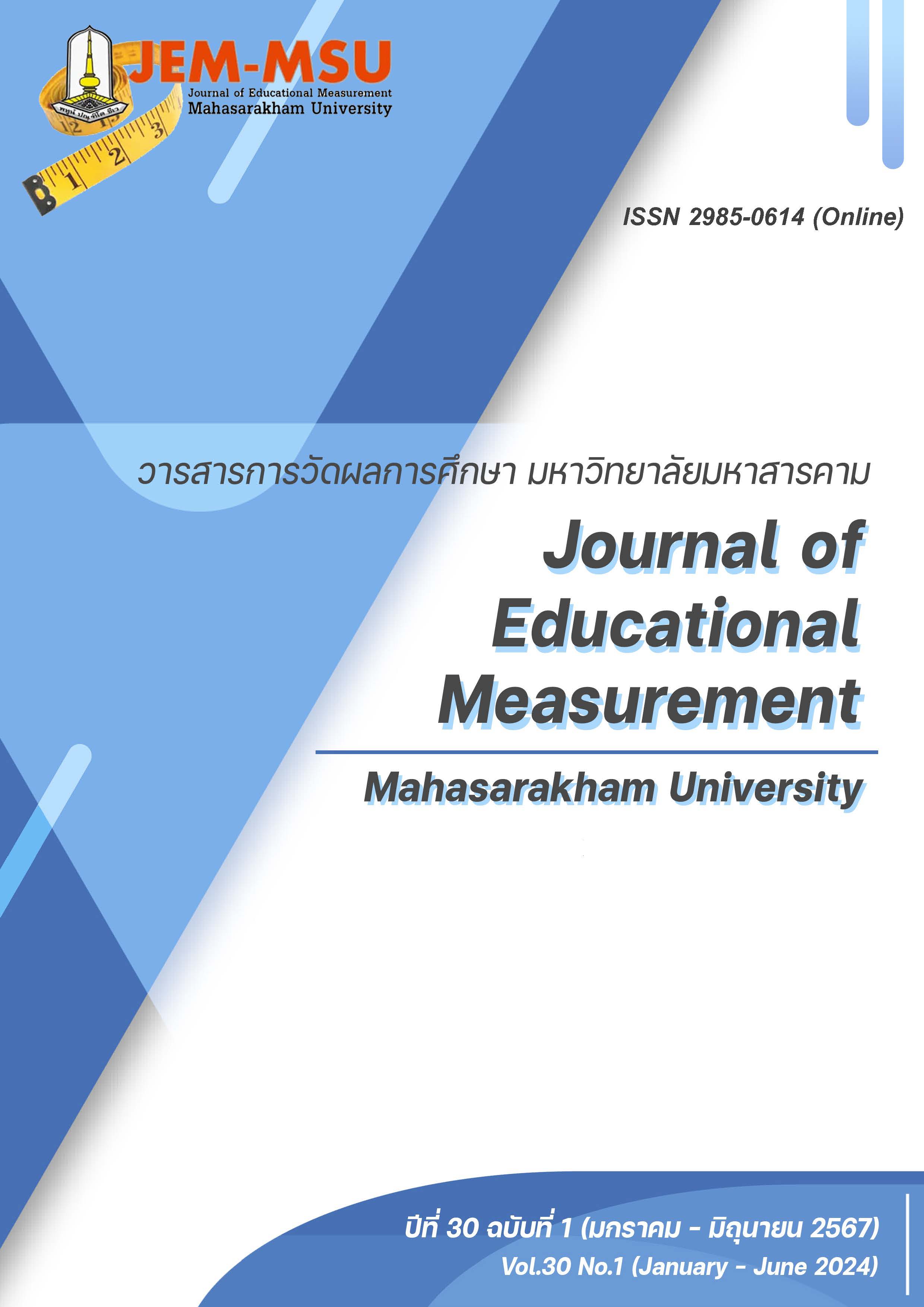Effect of distributed leadership on teaching quality with teacher autonomy and professional collaboration as the mediators: Evidence from Singapore’s 2018 TALIS data
Main Article Content
Abstract
This research was a study on the data in the Teaching and Learning International Survey 2018 (TALIS), collected by the Organization for Economic Co-operation and Development (OECD). The research had 3 main objectives. Firstly, to validate a proposed causal relationship model of distributed leadership. Secondly, to analyze the direct and indirect effects of distributed leadership on teaching quality. Finally, to test the mediating effects of teacher autonomy and professional collaboration on the relationship between distributed leadership and teaching quality. The sample consisted of 3,049 teachers from 169 schools in Singapore, which were drawn through stratified sampling. The research instrument was a 15-item Likert scale questionnaire, demonstrating a reliability range of .54 to .85. The research employed structural equation modeling (SEM) and bootstrapping techniques to test mediation. The result showed that the causal relationship model fit the empirical data. Distributed leadership had both direct ( = .11) and indirect (
= .13) effects on teaching quality, with statistical significance at the .05 level. The variables in the model together explained 15 percent of the variance in teaching quality. The mediation testing with bootstrapping (95% CI) showed that professional collaboration and teacher autonomy mediated the relationship between distributed leadership and teaching quality with an effect size of .08 and .05, respectively. The findings provide insight into the shared goal and shared decision-making processes in teacher development through distributed leadership in Singapore that may apply to the Thai education system.
Article Details

This work is licensed under a Creative Commons Attribution-NonCommercial-NoDerivatives 4.0 International License.
The content and information contained in the published article in the Journal of Educational Measurement Mahasarakham University represent the opinions and responsibilities of the authors directly. The editorial board of the journal is not necessarily in agreement with or responsible for any of the content.
The articles, data, content, images, etc. that have been published in the Journal of Educational Measurement Mahasarakham University are copyrighted by the journal. If any individual or organization wishes to reproduce or perform any actions involving the entirety or any part of the content, they must obtain written permission from the Journal of Educational Measurement Mahasarakham University.
References
Brown, C., Flood, J., Armstrong, P., MacGregor, S., & Chinas, C. (2020). Is distributed leadership an effective approach for mobilising professional capital across professional-learning networks? Exploring a case from England. Journal of Professional Capital and Community, 6(1), 64–78. https://doi.org/10.1108/JPCC-02-2020-0010
Buske, R. (2018). The principal as a key actor in promoting teachers’ innovativeness--analyzing the innovativeness of teaching staff with variance-based partial least square modeling. School Effectiveness and School Improvement, 29(2), 262–284. https://doi.org/10.1080/09243453.2018.1427606
Daniels, E., Hondeghem, A., & Dochy, F. (2019). A review on leadership and leadership development in educational settings. Educational Research Review, 27(3), 110–125. https://doi.org/10.1016/j.edurev.2019.02.003
de Jong, W. A., Lockhorst, D., de Kleijn, R., Noordegraaf, M., & van Tartwijk, J. (2020). Leadership practices in collaborative innovation: A study among Dutch school principals. Educational Management Administration & Leadership, 50(6), 891-1034. https://doi.org/10.1177/1741143220962098
Gallucci, M., & Jentschke, S. (2021). SEMLj: jamovi SEM Analysis [jamovi module]. Retrieved from https://semlj.github.io/help.html
Gopinathan, S. (2015). Singapore chronicles: Education. Straits Times Press.
Hair, J. F., Black, W. C., Babin, B. J., and Anderson, R. E. (2010). Multivariate data analysis (7th ed.). Pearson Education.
Hairon, S., & Tan, C. (2017). Professional learning communities in Singapore and Shanghai: Implications for teacher collaboration. Compare: A Journal of Comparative and International Education, 47(1), 91-104. https://doi.org/10.1080/03057925.2016.1153408
Hairon, S., Goh, J. W. P., & Lin, T. B. (2014). Distributed leadership to support PLCs in Asian pragmatic Singapore schools. International Journal of Leadership in Education, 17(3), 370-386. https://doi.org/10.1080/13603124.2013.829586
Hayes, A. F. (2009). Beyond Baron and Kenny: Statistical mediation analysis in the new millennium. Communication monographs, 76(4), 408-420.
Heck, R., & Hallinger, P. (2009). Assessing the contribution of distributed leadership to school improvement and growth in math achievement. American Educational Research Journal, 46, 659–689.
Hencke, J., Belanger, J., Sim, M., Broeks, M., Wagner, J.-P., Ebbs, D., & Penon, K. (2019). TALIS starting strong 2018 technical report. https://www.oecd.org/education/talis/TALIS-Starting-Strong-2018-Technical-Report.pdf
Hipp, K. K., & Huffman, J. B. (Eds.). (2010). Demystifying professional learning communities: School leadership at its best. Rowman and Littlefield Educational.
Hyslop-Margison, E. J., & Sears, A. M. (2010). Enhancing teacher performance: The role of professional autonomy. Interchange, 41, 1-15.
Ingersoll, R.M., & Merrill, E. (2011). The status of teaching as a profession. In J. Ballantine, & J. Spade (Eds.), Schools and Society: A Sociological Approach to Education (4th ed.). Sage Publications.
Kumari, L. (2021). A Study on Distributed Leadership Practices and its Impact on Teaching and Learning. PUPIL: International Journal of Teaching, Education and Learning, 5(1), 55-72. https://doi.org/10.20319/pijtel.2021.51.5572
Lin, Q. (2022). The relationship between distributed leadership and teacher innovativeness: Mediating roles of teacher autonomy and professional collaboration. Frontiers in Psychology, 13, 1-11. https://doi.org/10.3389/fpsyg.2022.948152
Liu, S., Keeley, J. W., Sui, Y., & Sang, L. (2021). Impact of distributed leadership on teacher job satisfaction in China: The mediating roles of teacher autonomy and teacher collaboration. Studies in Educational Evaluation, 71(3). 1-9. https://doi.org/10.1016/j.stueduc.2021.101099
Lomos, C., Hofman, R. H., & Bosker, R. J. (2011). The relationship between departments as professional communities and student achievement in secondary schools. Teaching and Teacher Education, 27(4), 722–731. https://doi.org/10.1016/j.tate.2010.12.003
Meirink, J. A., Imants, J., Meijer, P. C., & Verloop, N. (2010). Teacher learning and collaboration in innovative teams. Cambridge Journal of Education, 40(2), 161–181. https://doi.org/10.1080/0305764X.2010.481256
R Core Team (2021). R: A Language and environment for statistical computing. (Version 4.1) [Computer software]. Retrieved from https://cran.r-project.org
Shanmugaratnam, T. (2008). Foreword. In S.K. Lee, C.B. Goh, B. Fredriksen, & J. P. Tan (Eds.), Toward a better future: Education and training for economic development in Singapore since 1965 (pp. ix–x). World Bank.
Tamboli, A. (2020). Distributed Leadership for the Future of Work. https://etinsights.et-edge.com/distributed-leadership-for-the-future-of-work/
The jamovi project. (2022). jamovi (Version 2.3) [Computer Software]. Retrieved from https://www.jamovi.org
World Bank. (n.d.). Human Capital Index. World Bank Data Catalog. https://datacatalog.worldbank.org/search/dataset/0038030


